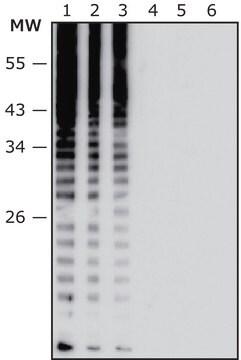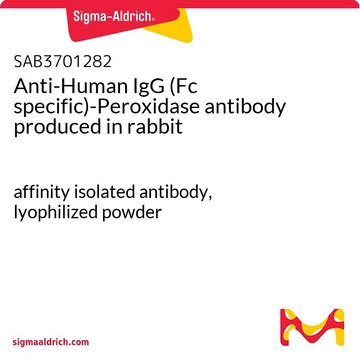SAB4200862
Anti-Salmonella enterica typhimurium antibody produced in rabbit
IgG fraction of antiserum
Synonym(s):
Salmonella typhimurium (Loeffler) Castellani and Chalmers
About This Item
Recommended Products
biological source
rabbit
Quality Level
antibody form
IgG fraction of antiserum
antibody product type
primary antibodies
form
liquid
species reactivity
(Salmonella enterica typhimurium)
packaging
pkg of 100 μL
pkg of 25 μL
concentration
~1 mg/mL
technique(s)
immunoblotting: 1:2000-1:4000 using Salmonella enterica typhimurium LPS
indirect ELISA: 1:2000-1:4000 using using whole Salmonella
shipped in
dry ice
storage temp.
−20°C
target post-translational modification
unmodified
General description
Specificity
Application
Biochem/physiol Actions
higher than the extracellular pH.6 Then, S. typhimurium penetrates the mucus barrier of the intestinal wall and adheres to the epithelium to initiate the infection, that may results in diarrhea, loss of electrolytes and local inflammation of the intestine.7-9
After S. typhimurium is being engulfed by enterocytes, it forms intracellular phagosomal compartments, termed Salmonella-Containing Vacuoles (SCV) where the bacterium is able to survive and multiply.2,9 S. typhimurium has various virulence factors, most of them are enoced by genes located in the Salmonella Pathogenicity Islands (SPI).10 S. typhimurium uses flagella for motility after ingestion11 and then type I fimbrae12 and adhesins to adhere to the epithelium. It expresses Type III Secretion System (T3SS) that enables the bacteria to inject into the host cells a variety of effector proteins such as, SipABCD, SptP, SpiC and SopB that alter cellular functions to promote bacterial invasion, survival and propagation.2,13,14 Moreover, S. typhimurium is able to form resistant biofilms15 that contribute to the establishment of chronic, ""carrier state"" infections. In addition, human specific S. typhiis used as a model for the animal study of typhoid fever.16
Physical form
Storage and Stability
Disclaimer
Not finding the right product?
Try our Product Selector Tool.
Storage Class Code
12 - Non Combustible Liquids
WGK
WGK 1
Regulatory Listings
Regulatory Listings are mainly provided for chemical products. Only limited information can be provided here for non-chemical products. No entry means none of the components are listed. It is the user’s obligation to ensure the safe and legal use of the product.
JAN Code
SAB4200862-VAR:
SAB4200862-100UL:
SAB4200862-BULK:
SAB4200862-25UL:
Certificates of Analysis (COA)
Search for Certificates of Analysis (COA) by entering the products Lot/Batch Number. Lot and Batch Numbers can be found on a product’s label following the words ‘Lot’ or ‘Batch’.
Already Own This Product?
Find documentation for the products that you have recently purchased in the Document Library.
Our team of scientists has experience in all areas of research including Life Science, Material Science, Chemical Synthesis, Chromatography, Analytical and many others.
Contact Technical Service







